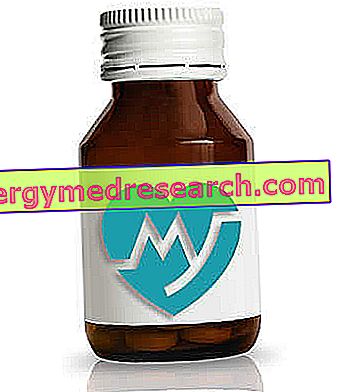NIFLURIL ® is a drug based on Niflumic Acid
THERAPEUTIC GROUP: Non-steroidal anti-inflammatory and antirheumatic drugs
IndicationsAction mechanismStudies and clinical effectiveness Usage and dosage instructionsWarnings Pregnancy and lactationInteractionsContraindicationsUndesirable effects
Indications NIFLURIL ® Niflumic Acid
NIFLURIL ® is indicated in the symptomatic treatment of pain associated with inflammatory states both acute and chronic, of rheumatic or post-traumatic origin.
Mechanism of action NIFLURIL ® Niflumic Acid
Niflumic acid, the active ingredient of NIFLURIL ®, is a drug belonging to the category of non-steroidal anti-inflammatories and in particular to the family of fenamates.
Taken orally niflumic acid is rapidly absorbed at the intestinal level, reaching maximum plasma concentration in about an hour, and being subsequently distributed to the various organs and systems linked to plasma proteins.
Here niflumic acid is able to exert a competitive inhibitory action against cyclooxygenases, enzymes expressed in inflammatory conditions, fundamental in the conversion of arachidonic acid into mediators with pro-inflammatory and algogenic activity known as prostaglandins.
The aforementioned therapeutic action materializes macroscopically in a series of benefits characterized by:
- Reduction of edema and swelling due to inflammatory processes;
- Reduction of pain exerted by mediators such as bradykinin on peripheral endings of nociceptors;
- Fever reduction, thanks to the inhibition of the production of mediators with central pyrogenic effect.
After its biological activity, niflumic acid is metabolized to the liver level and subsequently excreted, in the form of inactive catabolites, mainly via the kidney.
Studies carried out and clinical efficacy
1. NIFHLUMIC ACID AND GENE EXPRESSION
Ophthalmic Res. 2011 Mar 29; 46 (4): 181-186.
Experimental study that demonstrates how the administration of niflumic acid can modulate gene expression by inhibiting the production of some histamine-associated receptors involved in the conjunctival system in the classic allergic symptomatology.
2. THE PRO-APOPTOTIC ACTIVITY OF THE NIFLUMIC ACID
Cancer Lett. 2011 Jan 28; 300 (2): 134-44. Epub 2010 Nov 9.
Very interesting experimental work that demonstrates how the concomitant administration of niflumic acid and PPAR gamma, may facilitate the induction of the apoptotic process in lung cancer cells.
3. NIFLUMIC ACID AND TOXICOLOGICAL SCREENING
Arch Pediatr. 2009 Nov; 16 (11): 1457-60. Epub 2009 Aug 28.
Interesting pharmacokinetic study that demonstrates possible interferences related to the use of niflumic acid, on the monitoring of urinary concentrations of cannabinoid catabolites. This consideration becomes important for legal purposes in assessing the toxicological state.
Method of use and dosage
NIFLURIL ®
250 mg hard capsules of niflumic acid;
the prescription schedule for NIFLURIL ® varies according to the severity of the clinical picture and the physio-pathological condition of the patient.
However the therapeutic range between 250 - 1000 mg is generally very effective in improving painful symptoms.
In order to reduce the incidence and severity of side effects commonly associated with systemic NSAID therapy, it is recommended to take NIFLURIL ® in 3 - 4 daily administrations, preferably on a full stomach.
Warnings NIFLURIL ® Niflumic Acid
The therapeutic treatment with NIFLURIL ® should be understood as a short-term symptomatic therapy, useful for overcoming the painful symptoms on an inflammatory basis.
In order to reduce the number of adverse reactions as much as possible, NIFLURIL ® should be taken at the minimum effective dose and for the shortest possible time, preferably on a full stomach.
Particular caution should be recommended in all those patients suffering from cardiovascular, coagulative, renal, hepatic, allergic and gastrointestinal diseases, in which therapy with niflumic acid and NSAIDs more generally is generally associated with a greater incidence of complications.
If unwanted adverse reactions occur, the patient should immediately contact their doctor, with whom they can evaluate the possibility of suspending the drug therapy in progress.
PREGNANCY AND BREASTFEEDING
The use of NIFLURIL ® during pregnancy and in the subsequent lactation period is contraindicated due to the numerous experimental and clinical evidences that demonstrate the marked ability of niflumic acid and more generally of non-steroidal anti-inflammatory drugs to facilitate the appearance of fetal malformations or unwanted abortions.
Interactions
The patient receiving NIFLURIL ® should pay particular attention to the simultaneous intake of:
- Oral anticoagulants and inhibitors of serotonin reuptake, due to the increased risk of bleeding;
- Diuretics, ACE inhibitors, angiotensin II antagonists, methotrexate and cyclosporin, due to their ability to enhance the hepatotoxic and nephrotoxic effects of acetylsalicylic acid;
- Non-steroidal anti-inflammatory drugs and corticosteroids due to damage to the gastro-intesintale mucosa;
- Antibiotics, due to the variations induced in terms of pharmacokinetic and pharmacodynamic properties;
- Sulfonylureas, for alterations affecting glucose metabolism, potentially responsible for sudden and severe hypoglycemia.
Contraindications NIFLURIL ® Niflumic Acid
The intake of NIFLURIL ® is contraindicated in case of hypersensitivity to the active ingredient or to one of its excipients, angioedema, peptic ulcer, history of intestinal bleeding, ulcerative colitis, Crohn's disease or previous history for the same diseases, cerebrovascular bleeding, haemorrhagic diathesis or concomitant anticoagulant therapy, renal failure, liver failure, asthma, hypophosphataemia and viral infections.
Undesirable effects - Side effects
Therapy with niflumic acid, as well as that provided for other non-steroidal anti-inflammatory drugs, could be associated with the appearance of side effects.
Usually the frequency and extent of these adverse reactions is proportional to the duration of the therapy or to the possible presence of particular predisposing conditions.
Among the symptoms most frequently observed are: heartburn, gastralgia, nausea and vomiting, constipation and in severe cases ulcers and hemorrhages, increased bleeding time accompanied in severe cases by pancytopenia, loss of hearing and sight, headache, insomnia, drowsiness, confusion and tremor, erythema, rash, urticaria and in severe cases bullous reactions.
Different epidemiological studies have also described a clear association between NSAID intake and incidence of cerebral and cardiovascular complications.
Note
NIFLURIL ® can be sold under medical prescription.



